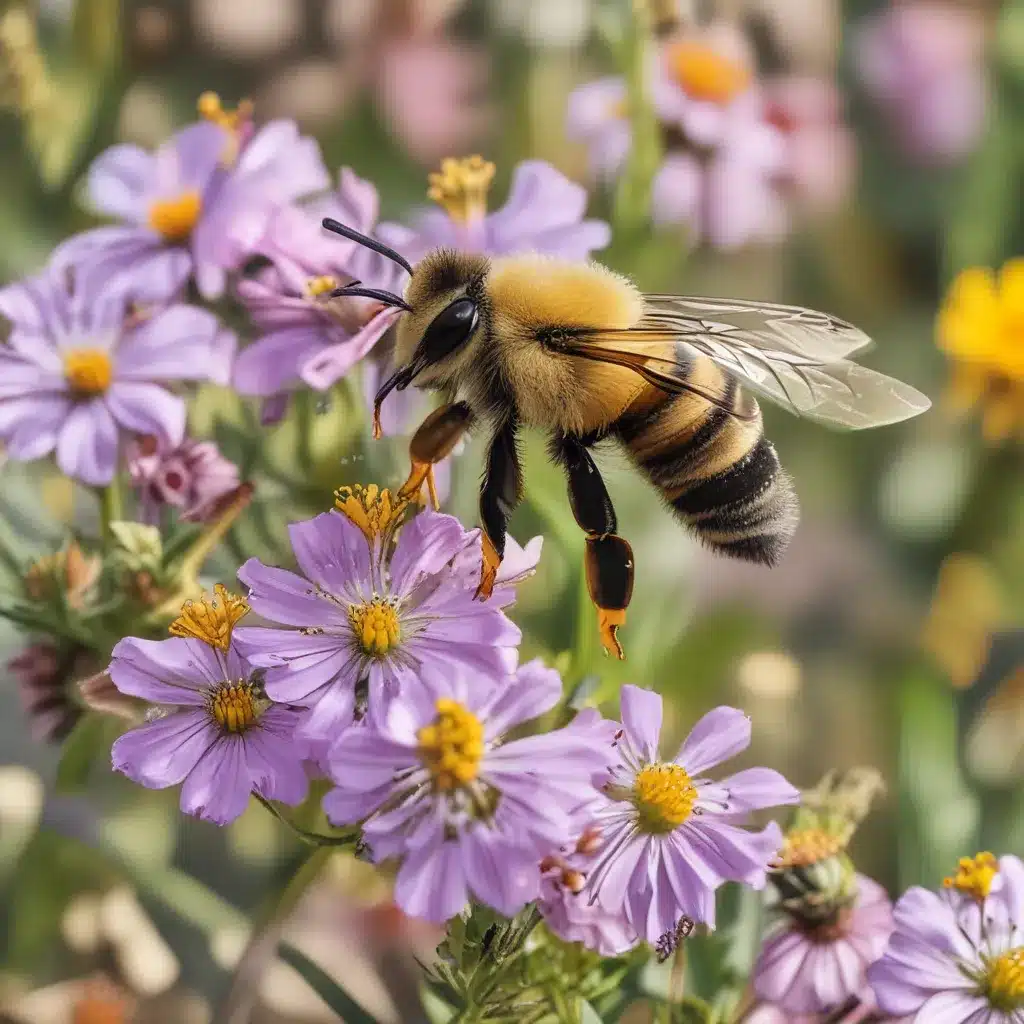
A Backyard Buzzing with Life
Ah, the joys of gardening – the vibrant colors, the fresh scents, the soothing sounds of nature. But have you ever stopped to wonder about the unsung heroes that make it all possible? I’m talking, of course, about our dear pollinator friends.
You see, I recently discovered that nearly three-quarters of the world’s flowering plants, including many of the fruits and vegetables we enjoy, rely on the tireless efforts of pollinators to thrive. And in North America alone, we’re blessed with close to 4,000 species of native bees – the true MVPs (Most Valuable Pollinators) of our natural ecosystems.
Bee-coming a Pollinator Powerhouse
Now, I know what you might be thinking: “But what about the honeybees? Aren’t they the bee’s knees when it comes to pollination?” Well, while the European honeybee is certainly a familiar face, it’s actually an introduced species, and not the evolutionary partner of our North American plant communities. Our native bees, on the other hand, have been hard at work for millennia, forging specialized relationships with the plants in their local habitats.
So, how exactly do these native bees stand out as the premier pollinators? For starters, they’re the only insects that deliberately collect pollen, using their specially-designed bodies to gather and transport it. And unlike the generalist honeybee, our native bees have evolved alongside specific plant species, becoming expertly adapted to their unique shapes, colors, and nectar rewards.
Creating a Bee-utiful Backyard Oasis
As natural habitats continue to dwindle, we gardeners have the power to provide a much-needed lifeline for these vital pollinators. And the best part? It’s as easy as letting our wild sides shine through in our own backyards and community gardens.
You see, the key to attracting a diverse array of native bees is to create a veritable pollinator playground – complete with a seasonal succession of blooms, a variety of nesting sites, and a strict no-pesticide policy. According to the Xerces Society, the premier champion of pollinator conservation, “the best bee gardens are in fact a little on the wild side” – trading in that manicured lawn for native wildflowers and leaving a few patches of bare, undisturbed soil for ground-nesting bees.
Painting a Pollinator Paradise
So, where do we start? Well, the first step is to ditch the one-size-fits-all approach and embrace the unique regional flair of our native plants. Studies have shown that native species are at least four times more attractive to our local pollinators than exotic imports.
By incorporating a diverse array of regional plant varieties, we can ensure that our buzzing backyard buddies have access to a veritable feast of nectar and pollen, from the early spring blooms of red-flowering currants to the late-summer splashes of goldenrod. And the best part? Many of these native beauties are incredibly low-maintenance, requiring little more than a sprinkle of water and an occasional deadhead.
Bee-lcoming Your Pollinator Guests
But it’s not just about the flowers, my friends. Those industrious native bees also need a place to call home, whether it’s a cozy tunnel in the soil or a snug little cavity in a fallen log. That’s why it’s important to leave behind a few “wild” patches in our gardens – areas free from thick mulch or manicured lawns that could block their access to nesting sites.
And speaking of guests, let’s not forget to roll out the welcome mat for all our pollinator pals. From the furry bumble bees to the iridescent green sweat bees, each species has its own unique preferences and adaptations. By planting a variety of flower shapes, sizes, and colors, we can ensure that every member of the pollinator community finds something to love in our gardens.
Bee-coming a Pollinator Protector
Of course, creating a bee-friendly oasis is only half the battle. We also need to safeguard our pollinator friends from the dangers that lurk in our modern landscapes, namely the dreaded pesticides.
As the Pollinator Partnership points out, these chemical culprits can have a devastating impact on our native bees, either killing them outright or impairing their ability to reproduce. And it’s not just the insecticides we need to worry about – herbicides can also wreak havoc by decimating the very flowers that pollinators rely on for sustenance.
Fortunately, there’s an easy solution: ditch the lawn chemicals and embrace the wild side of gardening. Hand-weeding may take a bit more elbow grease, but it’s a small price to pay for the front-row seat we’ll have to the pollinator parade in our gardens. And who knows – we might even discover a new favorite flower or two along the way.
Bee-coming Part of the Solution
So, are you ready to join me in creating a buzzing backyard oasis for our pollinator pals? By transforming our outdoor spaces into vibrant, pesticide-free havens, we can not only support the health and diversity of local ecosystems, but also play a vital role in safeguarding the future of our food supply.
Plus, it’s the perfect complement to your community-supported agriculture (CSA) membership – after all, what’s the point of enjoying all those delicious, locally-grown fruits and veggies if we don’t have the pollinators to ensure their continued bounty?
So, let’s roll up our sleeves, get a little dirt under our nails, and become the bee-roes our planet needs. Who’s with me?



